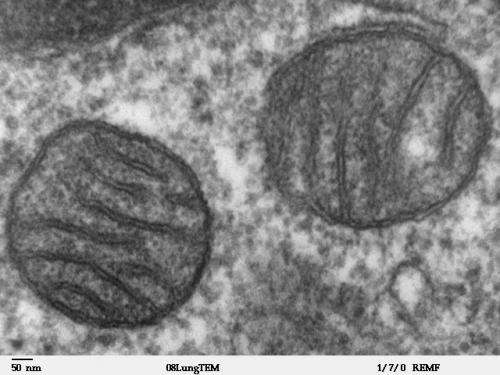May 10, 2017 report
Mitochondria found to run as high as 50 C

(Phys.org)—A team of researchers with members from France, Korea and Germany has found that temperatures inside human mitochondria can run as high as 50°C. In their paper uploaded to the preprint server bioRxiv, the group describes how they used temperature-sensitive dyes to determine the temperature of the organelles and what their findings might mean for prior biological research that has relied on lower temperatures during reactions.
The healthy human body is supposed to maintain a constant temperature of 37°C, but now it appears our cells may actually run much hotter. In this new effort, the researchers took the temperature of mitochondria in skin, kidney and lung cancer cells, and found them to be much hotter than was anticipated.
Because it is impossible with existing technology to take the temperature of mitochondria using conventional thermometers, the team took a new approach, applying a type of dye that changes color depending on the temperature of its environment. The dye, called Mito-Thermo-Yellow, binds to targets, and loses fluorescence as the temperature around it rises. When applied to the mitochondria, the team found that it could be used to accurately measure its temperature while still inside the cell.
Mitochondria are, of course, organelles that exist inside cells and serve the purpose of converting oxygen and other food into energy for the body to use as a power source. They do so by using oxygen to burn the food that we eat, leading to the creation of ATP—thus, it is not surprising that such cellular respiration results in the generation of heat—what is surprising, the researchers note, is how much.
The work comes on the heels of work done by a team in Japan that used a fluorescent dye to determine the temperature of mitochondria inside of cancer cells—they found temperatures there to be 6 to 9°C higher than normal body temperature.
Many in the media have noted that if the findings by this team prove reproducible by others, it could have a big impact on cellular research because many findings have been based on how quickly reactions occur inside the body at or near normal body temperatures.
More information: Mitochondria Are Physiologically Maintained At Close To 50 C, Dominique Chretien et al. biorxiv.org/content/early/2017/05/02/133223
Abstract
In warm-blooded species, heat released as a by-product of metabolism ensures stable internal temperature throughout the organism, despite varying environmental conditions. Mitochondria are major actors in this thermogenic process. The energy released by the oxidation of respiratory substrates drives ATP synthesis and metabolite transport, with a variable proportion released as heat. Using a temperature-sensitive fluorescent probe targeted to mitochondria, we measured mitochondrial temperature in situ under different physiological conditions. At a constant external temperature of 38 C, mitochondria were more than 10 C warmer when the respiratory chain was fully functional, both in HEK cells and primary skin fibroblasts. This differential was abolished by respiratory inhibitors or in cells lacking mitochondrial DNA, but enhanced by expressing thermogenic enzymes such as the alternative oxidase or the uncoupling protein UCP1. The activity of various RC enzymes was maximal at, or slightly above, 50 C. Our study prompts a re-examination of the literature on mitochondria, taking account of the inferred high temperature.
© 2017 Phys.org




















